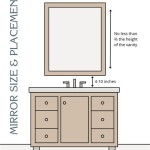How To Remove Small Bathroom Floor Tiles
Removing small bathroom floor tiles can be a necessary undertaking for renovation projects, repair work, or even addressing underlying issues like mold or water damage. While it can seem daunting, with the right tools, techniques, and careful planning, the process can be managed effectively. This article outlines the steps involved in removing small bathroom floor tiles, providing a comprehensive guide to ensure a successful outcome.
Before commencing any tile removal project, it is crucial to prioritize safety. Protective gear is essential to prevent injury from flying debris, sharp edges, and potentially harmful substances. This includes wearing safety glasses to protect the eyes, gloves to safeguard the hands, and a dust mask or respirator to avoid inhaling dust and particles. Additionally, wearing sturdy footwear will protect the feet from dropped tiles or tools.
Gathering the Necessary Tools
The right tools are paramount for efficient and effective tile removal. Having these tools readily available will streamline the process and minimize frustration. Essential tools include:
Chisel:
A small, sharp chisel is ideal for working with small tiles and accessing tight spaces.Hammer:
A standard hammer is needed to strike the chisel and break the tile's bond with the subfloor. A rubber mallet can also be useful for more delicate prying.Scraper:
A floor scraper with a wide blade is beneficial for removing residual thin-set mortar after the tiles are removed.Grout Removal Tool:
A grout saw or grout removal tool is necessary to remove the grout surrounding the tiles. This can be a manual tool or a power tool with a grout removal attachment.Shop Vacuum:
A shop vacuum is crucial for cleaning up dust and debris throughout the process.Putty Knife:
A putty knife can be used for prying up stubborn tiles and scraping away small amounts of thin-set.Safety Glasses:
Essential for protecting eyes from flying debris.Gloves:
Protect hands from sharp edges and potentially irritating materials.Dust Mask or Respirator:
Prevents inhalation of dust and particles.
Preparing the Bathroom for Tile Removal
Prior to starting the tile removal process, the bathroom should be adequately prepared. This involves protecting surrounding areas and ensuring proper ventilation. Removing fixtures and covering sensitive areas will prevent damage and simplify the work. The following steps should be taken:
Remove Fixtures:
If possible, remove the toilet, vanity, and any other easily removable fixtures from the bathroom. This will provide more working space and prevent accidental damage. If removal is not feasible, cover these fixtures with heavy-duty plastic sheeting and secure it with tape.Protect Surfaces:
Cover the bathtub, shower, and any other surfaces that could be damaged by falling tiles or debris. Use heavy-duty plastic sheeting or drop cloths and secure them with tape.Ventilation:
Ensure adequate ventilation by opening windows and using a fan to circulate air. This will help to reduce dust and improve air quality.Seal Doorway:
Seal the doorway to the bathroom with plastic sheeting and tape to prevent dust from spreading to other areas of the house.
Removing the Grout
The first step in removing the tiles themselves is to remove the grout surrounding them. This weakens the bond between the tiles and the subfloor and makes the tiles easier to remove. The method used for grout removal will depend on the type of grout and the tools available.
Using a grout saw, carefully run the blade along the grout lines between the tiles. Apply firm, even pressure and avoid pressing too hard, which could damage the surrounding tiles. For larger areas, a power tool with a grout removal attachment can speed up the process. Vacuum the grout lines after removing the bulk of the grout to clear debris.
The goal is to remove as much grout as possible without damaging the surrounding tiles or the subfloor. Take care when working near corners and edges to avoid chipping or cracking the tiles.
Removing the Tiles
Once the grout has been removed, the tiles can be carefully pried up from the subfloor. This process requires patience and a methodical approach to avoid damaging the subfloor. Begin by selecting a tile to start with, preferably one that appears loose or damaged.
Position the chisel at a 45-degree angle against the edge of the tile and gently tap it with the hammer. The goal is to break the bond between the tile and the thin-set mortar underneath. Work around the edges of the tile, applying gentle pressure to gradually lift the tile.
If the tile is particularly stubborn, try using a heat gun or hairdryer to warm the tile and soften the thin-set. Be cautious when using heat, as excessive heat can damage the subfloor or create a fire hazard. Continue working around the edges of the tile until it is loose enough to be pried up with the putty knife or chisel.
Once the tile is loose, carefully lift it up and set it aside. Avoid dropping the tile, as this could damage the subfloor or create a safety hazard. Repeat this process for each tile, working systematically across the floor.
Addressing Stubborn Tiles
Some tiles may prove more challenging to remove than others. These stubborn tiles may be firmly bonded to the subfloor, requiring additional effort to loosen them. Here are several techniques to address stubborn tiles:
Heat Application:
As mentioned earlier, applying heat to the tile can soften the thin-set mortar and make it easier to remove. Use a heat gun or hairdryer on a low setting and direct the heat towards the edges of the tile. Be careful not to overheat the tile or subfloor.Multiple Chisel Points:
Instead of focusing on one point, try using the chisel in multiple locations around the tile's perimeter. This can help to break the bond more evenly and prevent the tile from cracking.Score the Tile:
Use a tile scorer or a utility knife to score the surface of the tile in a grid pattern. This will weaken the tile and make it easier to break into smaller pieces, which can then be removed more easily.Leverage:
Use a pry bar or a larger chisel to provide more leverage when lifting the tile. Be careful not to apply too much force, as this could damage the subfloor.
Removing Thin-Set Mortar
After the tiles have been removed, a layer of thin-set mortar will typically remain on the subfloor. This mortar needs to be removed to create a smooth, level surface for the new flooring. The method used for removing the thin-set will depend on the type of mortar and the tools available.
Using a floor scraper, apply firm, even pressure and scrape away the thin-set mortar. Work in small sections and overlap each pass to ensure that all of the mortar is removed. For stubborn areas, use a chisel and hammer to chip away the mortar. Be careful not to damage the subfloor during this process.
Once the bulk of the mortar has been removed, use a shop vacuum to clean up any remaining dust and debris. Inspect the subfloor for any cracks or damage and repair them as necessary before proceeding to the next step.
Preparing the Subfloor
After removing the tiles and thin-set mortar, the subfloor should be thoroughly cleaned and prepared for the installation of new flooring. This involves removing any remaining debris, repairing any damage, and leveling the surface. The following steps should be taken:
Cleaning:
Use a shop vacuum to remove any remaining dust, debris, and loose particles from the subfloor. Pay close attention to corners and edges, where debris tends to accumulate.Inspection:
Inspect the subfloor for any cracks, holes, or other damage. Repair any damage with patching compound or concrete filler.Leveling:
Use a self-leveling compound to level the subfloor if necessary. This will ensure that the new flooring is installed on a smooth, even surface. Follow the manufacturer's instructions for mixing and applying the leveling compound.Priming:
Apply a primer to the subfloor to improve adhesion for the new flooring. Choose a primer that is compatible with the type of flooring being installed.
Disposing of Tile and Debris
Proper disposal of the removed tiles, grout, and thin-set mortar is important for environmental reasons and to maintain a safe and clean work environment. Check local regulations for guidelines on disposing of construction debris.
Place the broken tiles and grout in heavy-duty trash bags or containers. Thin-set mortar can be disposed of in the same manner, but it may be necessary to break it into smaller pieces first. If dealing with a large quantity of debris, consider renting a dumpster or contacting a waste disposal service.
Sweep and vacuum the work area thoroughly to remove any remaining dust and debris. Wipe down any surfaces that may have been contaminated with dust or mortar.
Safety Precautions During the Process
Throughout the tile removal process, safety should be a top priority. Dust and debris can pose health hazards, and sharp tools can cause injuries. Adhering to the following safety precautions will minimize risks:
Eye Protection:
Always wear safety glasses to protect the eyes from flying debris.Hand Protection:
Wear gloves to protect the hands from sharp edges and potentially irritating materials.Respiratory Protection:
Wear a dust mask or respirator to prevent inhalation of dust and particles.Foot Protection:
Wear sturdy footwear to protect the feet from dropped tiles or tools.Ventilation:
Ensure adequate ventilation to reduce dust and improve air quality.Safe Tool Handling:
Use tools properly and follow the manufacturer's instructions.Clean Work Area:
Keep the work area clean and free of clutter to prevent accidents.
By following these steps and taking the necessary precautions, removing small bathroom floor tiles can be a manageable task. The key is to be patient, methodical, and prioritize safety throughout the process. Preparation is paramount and will ensure a smooth transition to installing new flooring.

How To Remove A Tile Floor

How To Remove Stains From Bathroom Tiles

3 Best Ways To Get Rid Of Hard Water Stains From Bathroom Tiles Kent

Prep A Tile Floor Removal Bathrooms Remodel

Can You Reuse Ceramic Tile

How To Remove Tile Flooring Yourself With Tips And Tricks Removal Ceramic Floor

Advice On Cleaning Black Bathroom Tiles That Have White Residue Tiling Forum Tilers

Laying Floor Tiles In A Small Bathroom Houseful Of Handmade

How To Renovate Bathroom Without Removing Tiles Multipanel

How To Upgrade Bathroom Tile Without Replacing
Related Posts







